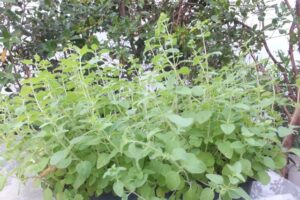Gourmet cooks with a greenhouse will already appreciate how growing herbs in the hotter drier conditions improves their strength and flavour. Many if not most grow Basil knowing how wonderfully flavoured this is fresh compared to the modicum left after preservation. You just cannot capture the essence. Which is why cooks also need to grow their own fresh Oregano, a traditional, nay essential cooks’ herb from the Mediterranean.

Slight confusion though may come in any search for that ‘authentic’ flavour. As ‘Oregano’ as sold and used is often has traditional additions. Thus ‘Pizza Spice’ Oregano, indeed almost all European ‘Oregano’, has Thymus capitata added. Secondly, Oregano collected from the wild in the Mediterranean is the red flowered O. vulgare, same as our Wild Marjoram which was once called Origanum. However these are very different strains because of differing hardiness, and thus flavour. The next conflation comes from the widespread culinary use and combination with the annual Sweet or Knotted marjoram, O. majorana with pale flowers.

Further, the cultivated forms diversified with the piquant flavour of the Italian, becoming more robust with the Greek and almost fierce with the Mexican selections. Indeed you can only have the appropriate strain for each cuisine by growing from packets of seed sold in those countries.
However any fresh Oregano is better than dried and it’s very easy. With a warm bright greenhouse you can have some fresh most days of the year. And as with many herbs it’s sensible not to cultivate individual specimens but to sow batches thickly and grow quickly, to cut and use. A standard seed tray is a convenient size though deeper ones are preferable.

Whichever sort you’ve got sow on the surface of moist sowing compost so roughly one seed lands per square cm. Sprinkle the tiniest amount of sowing compost on top and gently press down. Keep the compost just moist but never wet, warm and in full sun.
That’s it, nip off and use as required, when flowers start appearing trim back hard, and dry the trimmings. The batch can re-shoot and you can keep one going, often right through winter, but nicer more tender leaves are best had from newer fresher batches.
You could even amass an amazing collection as there are over six dozen species and varieties available many perennial and easily rooted from cuttings!


